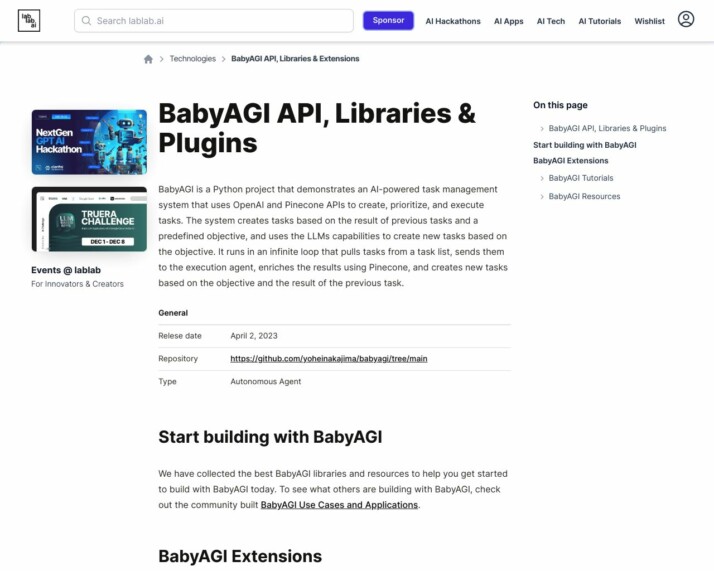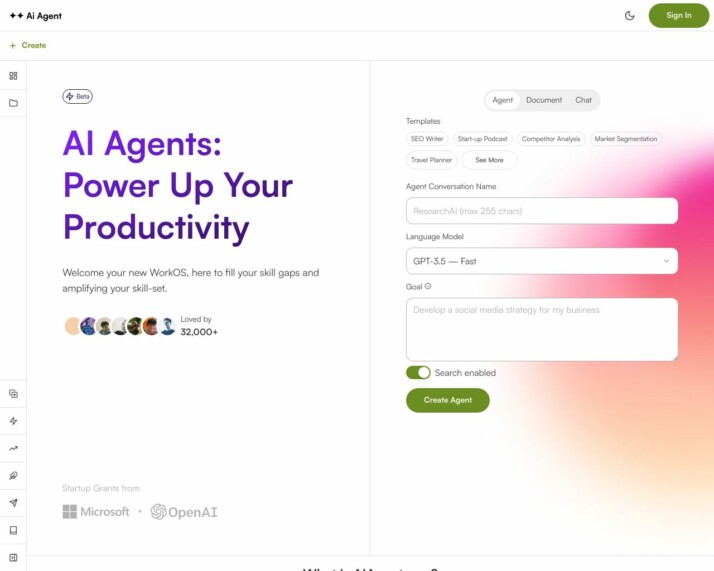Introduction
The accelerating pace of innovation in the field of artificial intelligence brings to light numerous significant contributors, and among them, BabyAGI vs AI Agent stand out. This article aims at drawing an insightful comparison between these two AI entities, delving into their unique offerings, salient features, target audiences, and more.
The multitude of options available in the tech market can make the choice of a suitable AI platform an overwhelming decision. Hence, we have undertaken an intensive study of these two popular agents – BabyAGI and AI Agent.
We invite you to join us as we dissect the similarities and differences between BabyAGI and AI Agent, delve deep into the unique propositions they offer, and analyze how effectively they cater to their distinct target audiences.
An Overview of BabyAGI: Features and Vision
Offering a unique approach to task automation, BabyAGI stands out with its innovative features. It primarily targets audiences including business professionals, developers, and people seeking AI personal assistants. Notably, industries requiring complex data analysis and retrieval can significantly benefit due to BabyAGI’s broad applicability.


Integrated with OpenAI’s GPT-4, BabyAGI also uses a vector search engine, indicating its proficiency in complex problem-solving. It adds tremendous value in task management by autonomously managing, and executing tasks with efficient use of AI technologies. BabyAGI does not support cloud-based hosting, implying it’s operated solely on user’s PC with integration of OpenAI’s API and database server Pinecone.
However, the setup process involves coding and command line operations. This suggests BabyAGI is not a no-code solution and requires coding understanding. Also, it doesn’t seem to support various types of file formats like MS Word, and TXT files, focusing mainly on task resolution and management.
On a brighter note, BabyAGI carries the capability to remember past interactions using Pinecone’s vector database. It uses this context in ongoing processes, essentially making it an autonomous agent. In terms of handling user interaction, BabyAGI has set up a technical interface to interact with AI.
BabyAGI’s unique selling points include its autonomous task execution which aims to decrease the user’s cognitive load. However, there is no data on features that ensure operation within ethical and predefined boundaries. Despite certain limitations, BabyAGI embodies a vision of making an AI assistant that handles a variety of tasks and aids in efficient task management.
An Easy-to-Understand Overview of AI Agent
AI Agents are pretty cool. They’re like super-smart helpers that make things easier for us humans. This company, in particular, has some amazing AI Agent offerings. For example, they have AI agents that can work on their own, taking care of tasks and making decisions without needing our help. These AI agents are really good at understanding and handling complex stuff, whether it’s to do with businesses or something else.
The company also offers a safe and secure internet home for these agents. This makes it easier for us to use them and also helps keep them running smoothly. It’s a bit like having a gym where these agents can train and get better. For those of us who like to chat with these AI helpers, the company has made it really easy. And what’s even better is that these AI agents can remember a lot of stuff thanks to something called a Vector Database.


One of the things that sets this company apart is how much they care about safety. They make use of OAuth, a type of internet security, to ensure that your interactions with the AI agents are safe and secure. They have a big vision of where they want to take their AI Agent products, and have already launched some that help us humans interact better with AI agents.
Interestingly, these AI agents can also handle software development roles, which not all companies provide. This means they can help with things like coding and managing software projects. The company’s AI Agent vision is to make these agents even smarter and more helpful in the future. We can’t wait to see where they’ll go next!
But who are these products for? The company has a wide AI Agent target audience. For example, businesses that want to improve their operations or reduce the workload might find these AI agents helpful. The same goes for customer service and support teams, operational teams, and development teams. But most importantly, they’re for anyone who wants to make their daily tasks a bit easier and more efficient.
Comprehensive Feature Comparison: BabyAGI, AI Agent, and SmythOS
Choosing the right tools for developing and maintaining Large Language Models (LLMs) can be challenging. Hence, we present a detailed comparison of features between BabyAGI, AI Agent, and SmythOS. This page will provide you with objective insights about the most relevant functionalities these platforms offer.
| Features | BabyAGI | AI Agent | SmythOS |
|---|---|---|---|
| Hosted Agents (Dev, Production) | ❌ | ✅ | ✅ |
| Environments (Dev, Production) | ❌ | ✅ | ✅ |
| Visual Builder | ❌ | ❌ | ✅ |
| No-Code Editor | ❌ | ❌ | ✅ |
| Memory & Context | ✅ | ✅ | ✅ |
| Autonomous Agents | ✅ | ✅ | ✅ |
| Explainability and Transparency | ❌ | ✅ | ✅ |
| Debug Mode | ❌ | ❌ | ✅ |
| Multimodal | ❌ | ❌ | ✅ |
| Problem-Solving Capabilities | ✅ | ✅ | ✅ |
The key differences between BabyAGI, AI Agent, and SmythOS significantly reflect on both the usability and functionality of these platforms. For example, while BabyAGI does not have a Visual Builder or No-Code Editor, AI Agent, and SmythOS offer these features, greatly simplifying the process of setting up and running LLMs for users without extensive coding experience.
Also, Explainability and Transparency, a feature unique to AI Agent and SmythOS, allows for better understanding and trust in the decisions made by AI.
Moreover, the debugging capabilities, a feature that only SmythOS provides, must not be overlooked. Debugging is crucial for identifying and correcting errors in LLMs, hence significantly reducing the time and effort required for development and maintenance. All these features have an immense impact on the productivity and efficiency of LLM development.
BabyAGI vs AI Agent: Who is it for?
The intended audience for BabyAGI and AI Agent is diverse, catering to various users with different requirements and preferences. Let’s delve deeper into the user base and understand how the platforms’ functionalities satisfy their needs.
- Business Professionals and Organizations: BabyAGI and AI Agent are well-suited for businesses and organizations seeking efficient task management and automation. These platforms can aid in handling routine tasks, data analysis, and complex problem-solving, potentially increasing productivity in various business operations.
- Developers and Tech Enthusiasts: BabyAGI and AI Agent integrate advanced technologies like GPT-4 and Pinecone’s vector search engine, making them appealing to developers and tech enthusiasts interested in cutting-edge AI applications.
- Individuals Seeking Personal Assistants: BabyAGI and AI Agent can be valuable tools for individuals looking for an AI-driven personal assistant to manage and automate daily tasks, enabling efficient time and task management.
- Industries with Complex Information Needs: Industries that require complex information retrieval and analysis, such as research, legal, finance, or healthcare, can benefit from BabyAGI and AI Agent. Their AI capabilities can assist in sifting through large volumes of data to find relevant information.
In summary, BabyAGI and AI Agent cater to a broad audience, ranging from business professionals seeking efficiency in task management to individuals and industries with complex information processing needs. Their unique combination of AI technologies positions them as versatile tools for various applications in both professional and personal contexts.
When comparing BabyAGI and AI Agent to SmythOS, it becomes evident that the former offers advanced language models and integration with technologies like GPT-4 and Pinecone’s vector search engine. This, coupled with its autonomous functioning and problem-solving capabilities, sets BabyAGI and AI Agent apart as powerful solutions in the AI landscape.
Conclusion
In this conclusion, we summarize the main points of comparison between BabyAGI, AI Agent, and briefly touch upon SmythOS. We discuss the strengths and weaknesses of BabyAGI and AI Agent, and potential use cases for each, with a swift mention of how SmythOS compares.
BabyAGI is described as an autonomous agent that generates and executes tasks based on given objectives, demonstrating autonomous functioning. It is primarily text-based and designed for task management and problem-solving. However, it lacks features such as explainability and transparency, debug mode, multimodal capabilities, and multi-agent collaboration. While it allows for human-AI interaction, there are no audit logs for analytics and it does not work as a team with multiple human members. Furthermore, it does not have constrained alignment, data encryption, OAuth support, or IP control. It is a shipped product that aims to automate various tasks using AI, but it does not provide hosted agents or distinct development and production environments.
AI Agent, on the other hand, offers autonomous AI agent capabilities, but lacks features such as explainability and transparency. It’s more technical and requires coding knowledge and command-line interfaces, making it less accessible to users with minimal coding experience.
In comparison, SmythOS stands out for its comprehensive and flexible AI integration capabilities, scalable infrastructure, and broad spectrum of deployment options. It provides hosted agents for both development and production, supports distinct environments, and features a visual builder and a no-code editor that cater to users who require ease of use in AI deployment.
It employs memory and context components for experience-based learning, enabling agents to store, retrieve, and update information over time. It also offers advanced debugging tools and logging capabilities for understanding the decision-making processes of AI agents. These additional features make SmythOS a preferred choice over BabyAGI and AI Agent.
Professionals responsible for maintaining and optimizing IT infrastructure, marketing and web management teams, and individuals seeking personal assistants can benefit from the capabilities of SmythOS. Its flexibility, advanced AI capabilities, scalability, and efficiency cater to a wide range of needs. In summary, SmythOS is designed for a diverse audience, from technical experts in AI to business users in need of AI-driven solutions.
Last updated:
Disclaimer: The information presented in this article is for general informational purposes only and is provided as is. While we strive to keep the content up-to-date and accurate, we make no representations or warranties of any kind, express or implied, about the completeness, accuracy, reliability, suitability, or availability of the information contained in this article.
Any reliance you place on such information is strictly at your own risk. We reserve the right to make additions, deletions, or modifications to the contents of this article at any time without prior notice.
In no event will we be liable for any loss or damage including without limitation, indirect or consequential loss or damage, or any loss or damage whatsoever arising from loss of data, profits, or any other loss not specified herein arising out of, or in connection with, the use of this article.
Despite our best efforts, this article may contain oversights, errors, or omissions. If you notice any inaccuracies or have concerns about the content, please report them through our content feedback form. Your input helps us maintain the quality and reliability of our information.
Alexander De Ridder
Co-Founder, Visionary, and CTO at SmythOS. Alexander crafts AI tools and solutions for enterprises and the web. He is a smart creative, a builder of amazing things. He loves to study “how” and “why” humans and AI make decisions.
Explore All Comparison Articles
Decisions vs. Sola: AI Workflow Automation Showdown
AI-powered workflow automation platforms revolutionize how businesses streamline operations and boost productivity. This comparison explores Decisions vs. Sola, and SmythOS,…
DeepOpinion vs. Sola: Comparing AI Automation Platforms
AI-powered automation platforms revolutionize business operations, but choosing the right solution can be challenging. This comparison of DeepOpinion vs. Sola,…
DevGPT vs. Sola: AI-Powered Development Tools Compared
AI-powered development tools revolutionize software creation, offering unprecedented efficiency and capabilities. This comprehensive review compares DevGPT vs. Sola, and SmythOS,…
Fine AI vs. Sola: Comparing AI Automation Tools
AI-powered automation transforms software development and business workflows, offering unprecedented efficiency and innovation. Fine AI vs. Sola present distinct approaches…
FlowiseAI vs. Sola: Comparing AI Automation Platforms
AI-powered automation revolutionizes business operations, driving efficiency and innovation across industries. FlowiseAI vs. Sola offer distinct approaches to harness this…
Gooey AI vs. Sola: AI-Powered Automation Platforms Compared
AI-powered automation platforms revolutionize how businesses streamline operations and enhance productivity. This comparison delves into Gooey AI vs. Sola, two…

